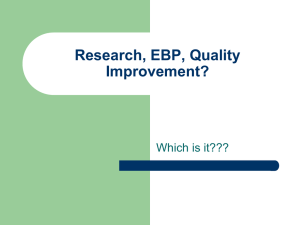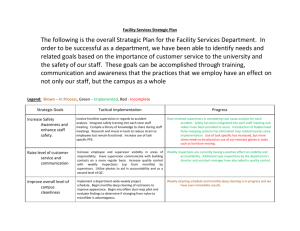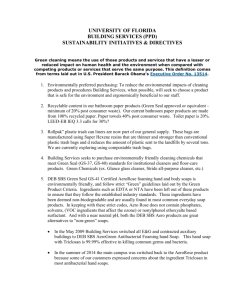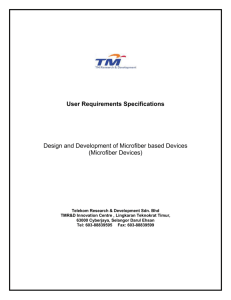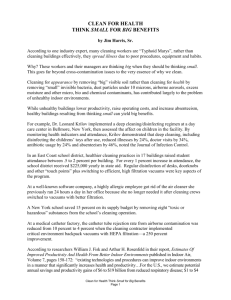10 Reasons to Use Microfiber Mopping
advertisement
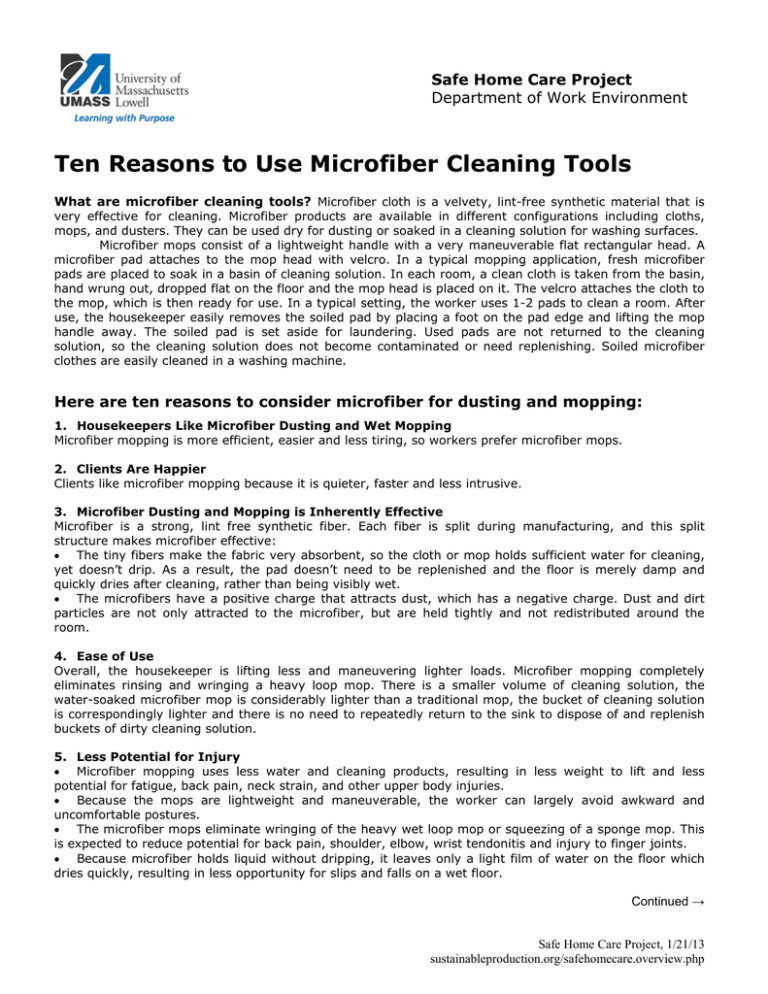
Safe Home Care Project Department of Work Environment Ten Reasons to Use Microfiber Cleaning Tools What are microfiber cleaning tools? Microfiber cloth is a velvety, lint-free synthetic material that is very effective for cleaning. Microfiber products are available in different configurations including cloths, mops, and dusters. They can be used dry for dusting or soaked in a cleaning solution for washing surfaces. Microfiber mops consist of a lightweight handle with a very maneuverable flat rectangular head. A microfiber pad attaches to the mop head with velcro. In a typical mopping application, fresh microfiber pads are placed to soak in a basin of cleaning solution. In each room, a clean cloth is taken from the basin, hand wrung out, dropped flat on the floor and the mop head is placed on it. The velcro attaches the cloth to the mop, which is then ready for use. In a typical setting, the worker uses 1-2 pads to clean a room. After use, the housekeeper easily removes the soiled pad by placing a foot on the pad edge and lifting the mop handle away. The soiled pad is set aside for laundering. Used pads are not returned to the cleaning solution, so the cleaning solution does not become contaminated or need replenishing. Soiled microfiber clothes are easily cleaned in a washing machine. Here are ten reasons to consider microfiber for dusting and mopping: 1. Housekeepers Like Microfiber Dusting and Wet Mopping Microfiber mopping is more efficient, easier and less tiring, so workers prefer microfiber mops. 2. Clients Are Happier Clients like microfiber mopping because it is quieter, faster and less intrusive. 3. Microfiber Dusting and Mopping is Inherently Effective Microfiber is a strong, lint free synthetic fiber. Each fiber is split during manufacturing, and this split structure makes microfiber effective: • The tiny fibers make the fabric very absorbent, so the cloth or mop holds sufficient water for cleaning, yet doesn’t drip. As a result, the pad doesn’t need to be replenished and the floor is merely damp and quickly dries after cleaning, rather than being visibly wet. • The microfibers have a positive charge that attracts dust, which has a negative charge. Dust and dirt particles are not only attracted to the microfiber, but are held tightly and not redistributed around the room. 4. Ease of Use Overall, the housekeeper is lifting less and maneuvering lighter loads. Microfiber mopping completely eliminates rinsing and wringing a heavy loop mop. There is a smaller volume of cleaning solution, the water-soaked microfiber mop is considerably lighter than a traditional mop, the bucket of cleaning solution is correspondingly lighter and there is no need to repeatedly return to the sink to dispose of and replenish buckets of dirty cleaning solution. 5. Less Potential for Injury • Microfiber mopping uses less water and cleaning products, resulting in less weight to lift and less potential for fatigue, back pain, neck strain, and other upper body injuries. • Because the mops are lightweight and maneuverable, the worker can largely avoid awkward and uncomfortable postures. • The microfiber mops eliminate wringing of the heavy wet loop mop or squeezing of a sponge mop. This is expected to reduce potential for back pain, shoulder, elbow, wrist tendonitis and injury to finger joints. • Because microfiber holds liquid without dripping, it leaves only a light film of water on the floor which dries quickly, resulting in less opportunity for slips and falls on a wet floor. Continued → Safe Home Care Project, 1/21/13 sustainableproduction.org/safehomecare.overview.php 6. Pollution Prevention & Reduction of Chemical Hazards Microfiber mops significantly reduce the amount of water and chemicals used. • With loop or sponge mops, soiled mops are rinsed in the cleaning solution. This requires frequent cleaning solution changes to prevent cross-contamination between rooms. With microfiber mops, only clean cloths are soaked in a small volume of cleaning solution. Hence, there is no need to replace the solution, considerably reducing the amount of water and disinfectant used and disposed down the drain. • Cleaning products often contain hazardous chemicals, such as butoxyethanol, quaternary ammonium compounds and phenols, which can cause respiratory irritation or skin burns. Reducing the volume of cleaners used and frequency of preparation minimizes exposure to these harsh chemicals. 7. • • • • Microfiber Mopping Streamlines Tasks and Takes Less Time The cleaning solution preparation is reduced considerably because of lower volumes used. The need to repeatedly transport, empty, and replenish large buckets of cleaning solution is eliminated. Replacing microfiber mop pads takes much less time than rinsing and wringing a loop mop. Microfiber mops are easier to manipulate in the room, reducing the mopping time. 8. • • • • • • Microfiber Mopping Can Reduce Costs Microfiber cloths and mops are readily available and reasonably priced. Unlike paper towels, microfiber cloths are durable and can easily be washed for reuse. The reduced volume of cleaning products results in avoided purchase costs. Reduced mopping time frees housekeepers to perform other productive tasks. Working conditions are likely to be safer due to the lower potential for injury. Eliminating the need for large mop buckets may reduce the storage area needed for supplies. 9. Contamination Hazards Are Reduced • Cloths and mop heads are easily replaced after every room and set aside for laundering. Because soiled cloths are never returned to the cleaning solution, risk of cross contamination between rooms is eliminated. • Some housekeepers choose to have different colored clothes for different areas, such as yellow for the kitchen; blue for toilets; orange for tubs, shower, sinks; and green for general dusting. 10. Laundering Resources Are Reduced Microfiber mop pads can be laundered in standard washing machines, while it is more difficult to clean loop or sponge mops. Microfiber cloths and mop heads require little space in the washers – s mall load is fine - saving on water, detergent and energy. (Avoid washing microfiber with high-lint materials, which will clog the microfiber.) And a Few Cautions… Always evaluate new products carefully to assess safety and performance in your own setting. You might need to evaluate the cleaning performance of different manufacturers’ products, as they are not all equally effective. The number of the mop pads or cloths used in a room will depend on the room size. Be sure to purchase enough to ensure a ready supply. Microfiber should not be laundered in industrial washers and dryers because high temperatures can damage the material. It is recommended to use standard washers with mild detergents that do not contain bleach, caustics or harsh cleaners that can degrade the microfiber. Microfiber mops should not be washed or dried with lint generating items, which will clog the microfiber. Be sure to consider how the microfiber cloths and mop pads will be laundered to ensure a rapid turnaround between use and laundering and to protect the performance capability of the microfiber. Safe Home Care Project, 1/21/13 sustainableproduction.org/safehomecare.overview.php
